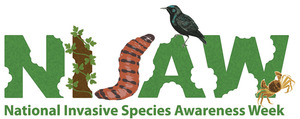 |
January 2019
|
 |
 |
Burmese Python Invasion in Florida a Hidden Legacy of Hurricane Andrew
This article by CBS News, although over a year old, provides an informative overview of the problems posed by the explosive expansion of the Burmese python (Python bivittatus) population in Florida.
"It's been 26 years since Hurricane Andrew became the costliest storm in Florida's history, but today residents of the Sunshine State are still paying the price in a way few would have imagined. Captive Burmese pythons let loose by Andrew's destruction have flourished in the southern Florida ecosystem, decimating local species in the process. And now there are signs this stubbornly invasive species may be poised to make its way beyond the state's borders."
On the article's page, you can also watch the CBSN Originals documentary, "Burmese Python Invasion: Fighting Invasive Species," which covers the python in Florida, as well as the lionfish and the Asian carp.
|
 |
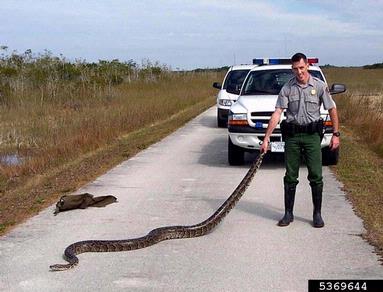
Credit: Bob DeGross, National Park Service, Bugwood.org
|
 |
 |
Texas Gulf Region CWMA to Hold Meeting and Other Events During Port Aransas Whooping Crane Festival
The Texas Gulf Region Cooperative Weed Management Area (TGR-CWMA) will be holding several events in association with the Port Aransas Whooping Crane Festival.
First, on Feb. 19, 9:30am – 4:30pm, there will be an invasive species identification and reporting training workshop. This free workshop will cover the Invaders of Texas citizen scientist program. The workshop will also present general information on invasive species, managing the spread of invasives and best management practices for control and removal of selected species. Space is limited to 30. Class meets in the Estuarine Research Center's Seminar Room at the University of Texas Marine Science Institute, 750 Channel View Dr., Port Aransas. Registration is first come, first served. REGISTER HERE *registration is required
Experts from American Conservation Experience and the Texas A&M Forest Service will hold a workshop on best practices for chainsaw and herbicide use when treating Brazilian Peppertrees. There will be an outdoor demonstration included. You are encouraged to bring your own equipment and personal protective gear such as chaps, forestry helmets and gloves. Class meets in the Estuarine Research Center's Seminar Room at the University of Texas Marine Science Institute Wednesday, Feb. 20, 9am - 12noon.
Also on February 20, the TGR-CWMA will hold a work day to remove Brazilian peppertrees, 1pm - 4 pm. Meet at the Leonabelle Turnbull Birding Center on Ross Avenue. Please dress appropriately and bring water. Tools and gloves provided, but bring your own gloves if you have them.
The CWMA's semiannual meeting will be held the next day, February 21, at 2pm, in the Estuarine Research Center's Seminar Room at the University of Texas Marine Science Institute. The meeting is open to the public and you are encouraged to attend. Come and meet us, and hear what the CWMA has accomplished and what we are planning.
And finally, the CWMA is seeking volunteers to be stationed at the Civic Center and birding sites throughout Port A on Feb. 22 - 24. Volunteers will greet visitors, answer questions and share information about invasive species management. The schedule of volunteer tasks and locations can be viewed here. Email csimpson@cityofportaransas.org to sign up.
Please RSVP HERE by Feb. 15th for each event you plan to attend.
See you there!
|
 |
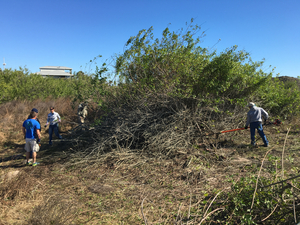
Credit: Hans Landel, Lady Bird johnson Wildflower Center
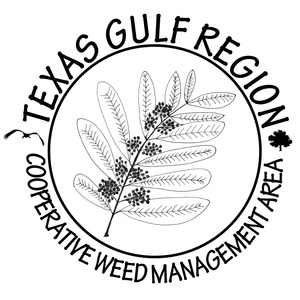 |
 |
 |
Impacts of Invasive Species Are Often Difficult to Predict
As we know, invasive species can negatively impact native animal and plant species. However, they can often go undetected for a long time, or their damaging impacts are not immediately clear. This phenomenon - referred to as crypticity - represents a huge challenge for the management of species communities and the conservation of biodiversity. An international team of researchers has developed a conceptual framework to deal with these aspects of uncertainty.
"We have developed a set of research methods and tools that will enable us to determine detrimental species and properties, as well as spatial and temporal changes, more effectively. Citizen scientists, for example, can provide support by helping researchers to find invasive species [emphasis added]; while long-term monitoring and research help us to determine critical developments in good time," stated Ivan Jaric, a researcher from the Biology Centre of the Czech Academy of Sciences and lead author of the study. Learn more at sciencedaily.com.
|
 |
.jpg)
Invasion Curve. At low populaton size, eradication is easiest, but detection is most difficult. Credit: GAO Report GAO-16-49
|
 |
 |
Invasive Spotlight:
Water Lettuce
(Pistia stratiotes)
As a floating aquatic plant, water lettuce causes problems similar to giant salvinia: it blocks light to the aquatic ecosystem, reduces oxygen levels, increases siltation, reduces suitable fish spawning habitat and restricts water flow and boating traffic. Also like giant salvinia, after it gets into lakes, ponds and slow-moving streams, it can multiply rapidly and cause severe infestations. Water lettuce spreads by vegetative offshoots that break off, as well as by seeds.
Water lettuce is very easy to identify: it resembles a floating open head of lettuce and may be found singly or in abundance. Its light grey-green leaves are thick, hairy, obviously ridged, and widest at the ends. Its flowers are not seen except under close examination.
For more information, see the Texasinvasives.org profile, and the UF / IFAS Center for Aquatic and Invasive Plants' weed alert, recognition card, and page from Identification and Biology of Nonnative Plants in Florida’s Natural Areas – Second Edition.
|
 |
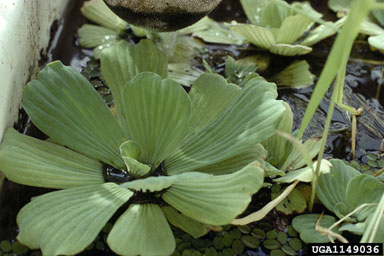
Credits: USDA APHIS Archives, Bugwood.org
|
 |
 |
More News
Bitter Cold Likely Killing Emerald Ash Borer Larvae
The bitter cold snap that has gripped the northern tier of the United States has a silver lining: it may be killing off as much as 90% of the emerald ash borer (Agrilus planipennis) larvae in areas where the temperature is dropping below 30º F. The cold may also be detrimental to aquatic invasive species. (In Texas, a cold snap can kill giant salvinia.). Learn more at KBJR6.com.
Beech Trees Are Dying, and Nobody's Sure Why
A confounding new disease is killing beech trees (Fagus grandifolia) in Ohio and elsewhere, and plant scientists are sounding an alarm while looking for an explanation. Researchers and naturalists in northeastern Ohio report on the emerging 'beech leaf disease' epidemic, calling for speedy work to find a culprit so that work can begin to stop its spread. Learn more at sciencedaily.com.
Is Habitat Restoration Actually Killing Plants in the California Wildlands?
New work shows for the first time just how widespread and deadly the threat of pathogens from restoration nurseries may be to natural forests. The team surveyed five native plant nurseries in Northern California and found that four harbored non-native Phytophthora pathogens. However, new management techniques, coupled with new methods for detecting pathogens, can help these nurseries limit the spread of exotic pathogens into the wild. Learn more at sciencedaily.com.
Bee Mite Arrival in Hawaii Causes Pathogen Changes in Honeybee Predators
Entomologists have performed a study on the Big Island and found viruses associated with the varroa mite (Varroa destructor), a parasite of honeybees, have spilled over into the non-native western yellowjacket (Vespula pensylvanica), a honeybee (Apis mellifera) predator and honey raider. The result is a hidden, yet remarkable, change in the genetic diversity of viruses associated with the larger pathogen community of the mite and wasp, with repercussions yet to be understood. Learn more at sciencedaily.com.
Insect Biological Control Shields Tropical Forests
An international team of scientists has just revealed how on-farm biological control can slow the pace of tropical deforestation and avert biodiversity loss on a macro-scale. The case study concerns biological control of the invasive mealybug Phenacoccus manihoti with the introduced host-specific parasitic wasp Anagyrus lopezi in Southeast Asia. Learn more at sciencedaily.com.
Big Genome Found in Tiny Forest Defoliator
Scientists have sequenced the genomes of the European gypsy moth (Lymantria dispar dispar) and its even more destructive cousin, the Asian gypsy moth (L. dispar asiatica, L. dispar japonica, and other subspecies). Learn more at sciencedaily.com.
Scientists Forecast Where Is the Highly Invasive Fall Armyworm to Strike Next
As a pest on many economically important crops, the fall armyworm moth (Spodoptera frugiperda), which is native to the Americas, is already a huge threat to the world's yield. For example, it only took 2 years for the pest to establish throughout sub-Saharan Africa. A study looks into the factors and likelihood for it to spread to other regions and continents. Learn more at sciencedaily.com..
Biosecurity Strategy Needed for China's Belt and Road Initiativet
China's Belt and Road Initiative (BRI), launched five years ago, includes more than 120 countries, linked by six proposed land-based Economic Corridors between core cities and key ports along traditional international transport routes. But, as new evidence shows, the risk of introducing invasive species into new areas is substantial. Learn more at sciencedaily.com.
|
 |
 |
If you would like to highlight a successful invasive species project or nominate a special person to be highlighted in an upcoming iWire, please send the details to iwire@texasinvasives.org.
|
 |
 |
|
|
 |
Sentinel Pest Network and Invaders of Texas Workshops
Invaders of Texas workshops train volunteers to become citizen scientists to detect and report invasive species. Workshops, which are free, include information on the Sentinel Pest Network, which serves to increase the awareness and early detection of the Emerald Ash Borer, Cactus Moth, Asian Longhorned Beetle, and other pests of regulatory significance.
Workshops are tailored to meet the interests of your volunteer group, and supplementary session examples include an introduction to the TX Invaders mobile application and the Eradicator Calculator, a feature on Texasinvasives.org designed to help organize and track volunteer-based eradication efforts.
Upcoming Workshops:
Saturday, February 2, 2019
Location: Mabee Library Auditorium, Headwaters of the Incarnate Word (San Antonio, TX)
Contact: Pamela Ball
Tuesday, February 19, 2019
Location: Estuarine Research Center's Seminar Room at the University of Texas Marine Science Institute (Port Aransas, TX)
Contact: Hans Landel
Saturday, March 16, 2019
Location: Camp Kubena (Ledbetter, TX)
Contact: Judith Deaton
NOTE: registration not open yet
For more information or to register to attend a free workshop, please visit the Workshop Page. |
 |
 |
|




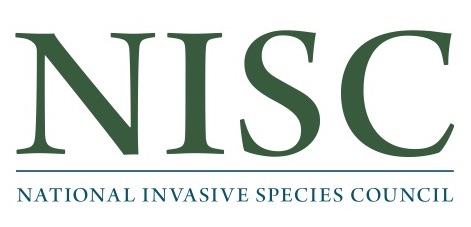
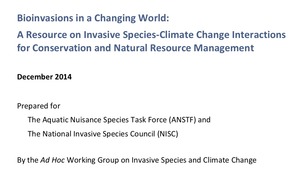
.jpg)

